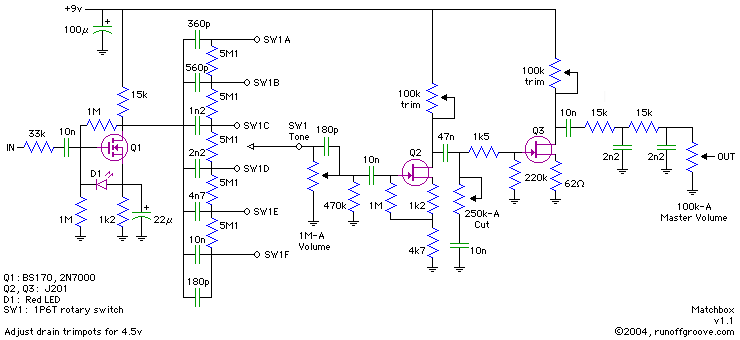

Back in the mid-90s, the Matchless DC/30 became one of the first boutique amps to hit the market. It excelled at clean tones, as well as thick Vox-like overdriven lead sounds.
There is good reason for the similarity in sound to a Vox amp. The lead channel of the DC/30 appears to be a modified Vox AC30/4. The AC30/4 amp featured the EF86 pentode preamp tube, just as the Matchless design.
runoffgroove.com set out to capture the lead sound of the Matchless DC/30 amp, using the technique developed by Doug Hammond for his excellent Meteor circuit.
We opted for a MOSFET to replace the EF86 tube. The MOSFET has better gain and fidelity attributes than the JFETs we normally use. We used J201 JFETs for the remaining two stages.
We've named this circuit the Matchbox.
An item of interest in this circuit is the odd-looking Tone control. This is in some ways similar to the FAC control on old Orange amplifiers. The sound is "thinnest" on setting A, and gets thicker as you progress through the settings. The Cut control acts as a simple Low Pass Filter. As you turn it counter clockwise, it will roll off some of the treble frequencies. We departed from the schematic a bit here. We used a 10n cap where the amp used only a 2n2. The reason for our deviation is to achieve a more dramatic effect.
NOTES:
- Try using a different MOSFET for the first stage. A 2N7000 sounded a bit "tighter" than a BS170. BS170 had a nice "loose" sound.
Any N-channel MOSFET can be used, but as always, pay close attention to the pinout. - Try to use all metal film caps in this circuit. It really seems to add to the smoothness of the sound. Ceramic caps or "greenies" will work fine, but you will probably notice a bit more "grainy" sound.
- A 12v Zener diode can be used in place of the LED used for static protection of the MOSFET.
- Philip Miller Tate (a.k.a. Ge_Whiz) found the Cut control to be quite subtle when using the stock values. He reports that substituting a 47nF capacitor and 50k-B pot provided a much more effective control.
- You can use other JFETs, but be warned! The middle stage may not bias correctly or have enough gain to distort. Try other transistors at your own risk. PLEASE do not post on Aron's Stompbox Forum with a complaint about the circuit does not working or sounding good when you do not use the specified components. You can always purchase J201 FETs from our friend, Steve Daniels at www.smallbearelec.com, who will ship to anywhere in the world.
- The official build used a Lorlin 2P6T rotary switch, Mouser Part #105-14572. On the back of the switch, there are letters and numbers by each solder lug. Wire terminal A to lug three of the Volume control. Wire terminals 1 to 6 to their respective nodes on the perfboard.



Here are pin voltages from the official runoffgroove.com build to provide a baseline (supply voltage from a 9.1v battery):
| Q1 BS170 | Q2 J201 | Q3 J201 | |||
| D | 4.8 | D | 4.8 | D | 4.8 |
| G | 2.4 | S | 1.0 | S | 20mV |
| S | .300 | G | .500 | G | 0 |









0 komentar: